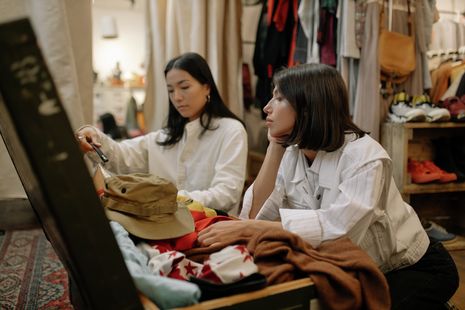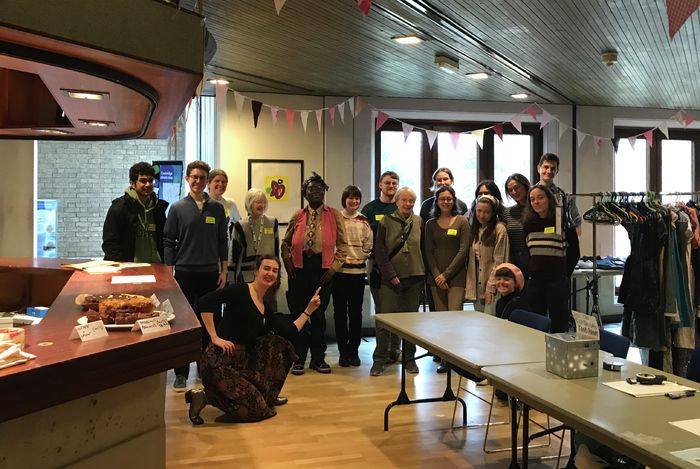Is second-hand shopping a cover up for overconsumption?
Shopping second-hand is touted as a way to enjoy fashion guilt-free. However, Jennifer Cartwright asks how much is too much when it comes to our thrifted finds

From the high street to the high end, the fashion industry has a huge problem: overconsumption. As 100 billion new items of clothing are made every year, garment production has created enormous environmental bruises and cultures of employee exploitation on a scale almost impossible to comprehend. Personally, with eyes far bigger than my closet, I am part of the issue. Yet, I’m also an avid second-hand shopper and most of my clothes are pre-owned. So how am I opting for the more sustainable option yet still contributing to the fast fashion problem?
There are numerous benefits to buying second-hand. Reselling gives clothes a new lease of life; this saves them from the landfill alternative where globally an estimated 92 million tonnes of textile waste goes each year. It also means that your money goes to an independent seller rather than a mass corporation, slightly reducing their ethically dubious profits and looking stylish whilst doing it. There are personal perks too: shopping second-hand is generally cheaper, offers more unique finds, and thanks to the Depop entrepreneurs and TikTok thrifters, buying pre-owned has become certifiably cool. The revival of Y2K style has seen old designs from 2000s brands such as Jane Norman and Miss Sixty recirculate whilst at the other end of the spectrum, the designer vintage wardrobes of Olivia Rodrigo and Bella Hadid proves that even A-List celebrities want to be seen making old things new.
“Reselling culture means items of clothing often spend longer in parcels than they do on our bodies”
However, since second-hand shopping is generally better for the planet and better for my purse, I’ve fallen into the trap of doing it a bit too much. The bargains at car boot sales and charity shops means that I feel like I’ve saved money whilst buying far more than I need or can realistically wear. Fashion is fun and no one should be shamed for wanting to wear something new, but the ease of second-hand shopping encourages buying to extreme excess. Reselling culture means items of clothing often spend longer in parcels than they do on our bodies. Second-hand platforms such as Depop and Vinted, see users repeatedly buy something, wear it once, and sell it again, at minimal economic loss. If the item can’t be sold again, its next destination may be a charity shop. But charity shops often don’t have the capacity to accept every single donation, especially if the quality is low. If this is the case, at best the item will become lost in a wardrobe, at worst, it will end up back on the route to landfill.
Some of the most notorious fast fashion producers such as PrettyLittleThing and Zara, have created online marketplaces fuelling this culture of buying, selling and buying again whilst disguising it as sustainable. By creating self-contained platforms where consumers can sell old clothes, both brands appear environmentally and socially conscious. Truly, it is great that these companies are doing something, but as both brands drop hundreds of new styles every month, they contradict the same sustainability they promote.
“Technically anything you wear once is fast fashion, regardless of where you bought it from”
As proven by these marketplaces, ‘second-hand’ is a buzzword within fashion circles. Yet often it is used to describe options which aren’t always all that sustainable. Surely it is better to buy something first hand and wear it 1,000 times in different ways than to buy second-hand only to then immediately throw it away? Technically, anything you wear once is fast fashion, regardless of where you bought it from; the problem is not where we buy but how much we buy. As the fashion industry accelerates at a pace quicker than the cars from Fast and Furious, maybe it’s time to put our foot on the brakes.
Amidst my own addiction to second-hand shopping, I think I’ve fallen out of love with clothes. It turns out the adrenaline rush of buying new things, whether first-hand or second, does not last long before it is already on to the next thing. With a focus on quantity rather than quality, I’ve bought things that have worn away before I’ve even had the chance to wear them out. Clothes are meant to be loved and I should be taking better care of mine.
In moderation, second-hand shopping is a great way to help slow the fashion cycle down. There is nothing wrong with falling in love with clothes, but limiting how much you consume saves you money and saves the environment from unnecessary damage and waste. I’ve found amazing second-hand things including the perfect-fit jeans, Halloween costumes, and even a Cambridge formal outfit for £3, however the joy of thrifting should be small surprises like these rather than buying as much as physically possible. Overconsumption, regardless of whether you are the first, second, third or forth hand buyer, increases the demand for even more clothes to be produced to a grave environmental and social cost. We all need to think before we buy. So go out, invest in pieces you will treasure, but make sure you make them last.
 News / Cambridge students set up encampment calling for Israel divestment6 May 2024
News / Cambridge students set up encampment calling for Israel divestment6 May 2024 News / Cambridge postgrad re-elected as City councillor4 May 2024
News / Cambridge postgrad re-elected as City councillor4 May 2024 News / Proposed changes to Cambridge exam resits remain stricter than most7 May 2024
News / Proposed changes to Cambridge exam resits remain stricter than most7 May 2024 News / Some supervisors’ effective pay rate £3 below living wage, new report finds5 May 2024
News / Some supervisors’ effective pay rate £3 below living wage, new report finds5 May 2024 Fashion / Class and closeted identities: how do fits fit into our cultures?6 May 2024
Fashion / Class and closeted identities: how do fits fit into our cultures?6 May 2024






